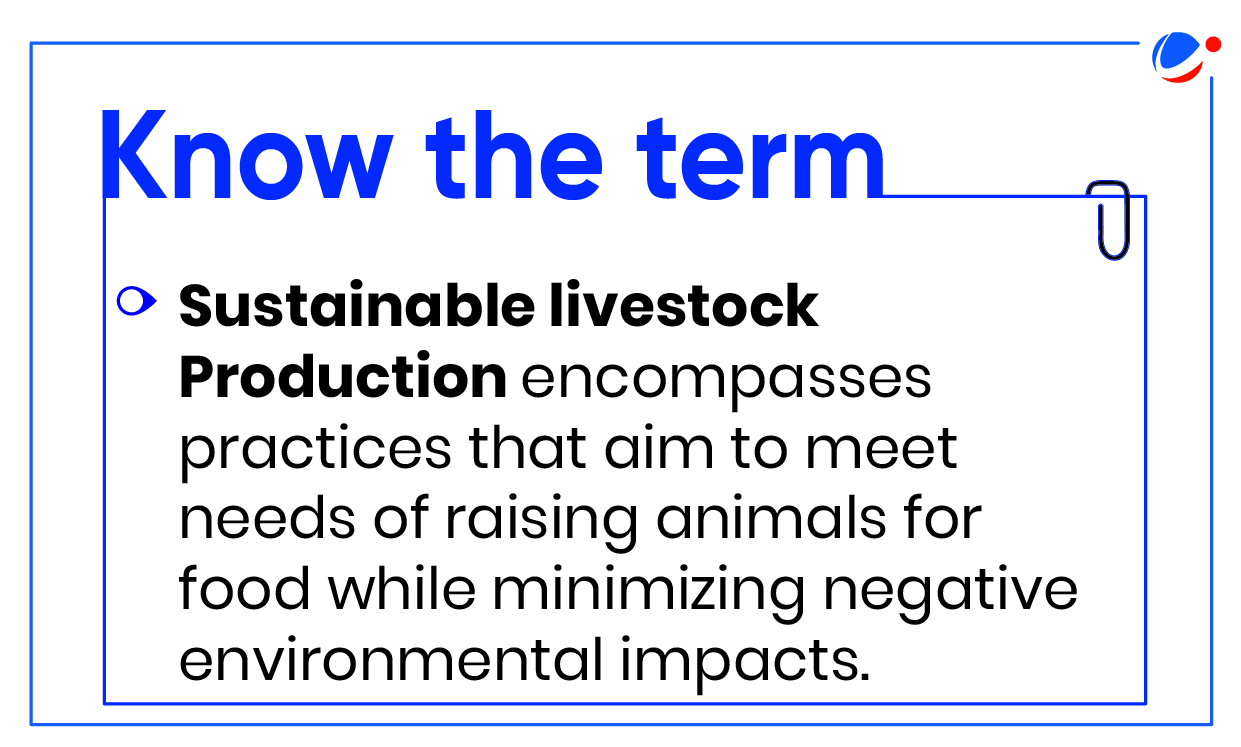Why in the news?
Cabinet approved sustainable livestock health and production scheme with a total outlay of Rs 1,702 crore, the decision aims to Increase farmers income from livestock and dairy.
More on the News

- Scheme is comprised of following:
- Animal health management and veterinary education
- Dairy production and technology development
- Animal genetic resource management, production and improvement
- Animal nutrition and small ruminant production and development
Status of Livestock Sector in India
- India has world's largest population of livestock.
- India is largest producer of buffalo meat and 2nd largest producer of goat meat.
Significance of Livestock Sector in India
- Contribution to GDP: Contribution to total Livestock GVA (at constant prices) was 30.19% of Agricultural and Allied Sector GVA and 5.73% of Total GVA in 2021-22.
- Employment Generation: Livestock rearing is a major source of livelihood for over 70% of rural households in India, with a significant proportion being small and marginal farmers and landless laborers.
- Interlinkages with Agri-activities: Livestock sector is crucial for production of organic inputs like manure and agricultural waste is used as fodder for animals.
- Food and Nutritional Security: Livestock products such as milk, meat, and eggs are rich in essential nutrients, playing a crucial role in combating malnutrition, especially among children and women.
- India is ranked 1st in milk production contributing 23% of global milk production.
Issues faced by livestock sector in India:
- Health and Veterinary Issues:
- High economic losses due to animal diseases: E.g., Haemorrhagic Septicaemia, Foot and Mouth Disease, Brucellosis, etc.
- Also, zoonotic diseases can be transmitted between animals and humans, as evidenced by recent outbreaks like COVID-19, Ebola, and avian influenza
- Inadequate infrastructure and human resources: India has less than 60 recognized veterinary colleges in India, which are inadequate to turn out the required number of vets.
- Rise of Anti-Microbial Resistance: India ranks 4th in antibiotics use in animals, wherein poultry sector is the largest reservoir of antibiotics.
- High economic losses due to animal diseases: E.g., Haemorrhagic Septicaemia, Foot and Mouth Disease, Brucellosis, etc.
- Economic Issues:
- Low Productivity: Due to inadequate nutrition, poor management practices, and low genetic potential of local breeds.
- Average annual productivity of cattle in India is 1777 kg/animal/year as against the world average of 2699 kg/animal/year (2019-20).
- Unorganized Sector: About half of total meat production comes from un-registered, make-shift slaughterhouses.
- High Marketing and transaction costs: of livestock products at around 15-20% of sale price.
- Low insurance cover: Only 15.47% of animals are under insurance cover.
- Shortage of fodder: India has only 5% of its cultivable land under fodder production while having 11% of livestock, creating a huge pressure on land, water and other resources.
- Low Productivity: Due to inadequate nutrition, poor management practices, and low genetic potential of local breeds.
- Inadequate attention towards extension services: There is no exclusive livestock extension program, and most services are animal health-focused, not extension-focused.
- Green House Gas emissions: Enteric methane emission from Indian livestock contributed 15.1% total global enteric methane emissions.
Initiatives for India's Livestock Sector
|
Way Forward
- National Animal Disease Reporting System (NADRS) requires to be strengthened with infrastructural support and digitalization for real-time reporting of disease outbreaks.
- Mobile veterinary services for remote areas to provide first aid, artificial insemination, deworming, and vaccination services at farmers' doorstep.
- To set up a national working group to review staff levels and training needs at DADF and state AHDs.
- Promote Livestock-based integrated farming system (IFS) to integrate crop cultivation, livestock rearing, and other agricultural activities to optimize resource use, enhance productivity, and ensure sustainability.
- Facilitating access to markets, establishing efficient value chains, and promoting digital platforms for marketing and information dissemination.
- Increase insurance Coverage in Livestock Sector to shift the livestock owners' risk to insurance companies.
- Formulating Area-specific policy. E.g. policy focus in rain-fed areas should be on livestock rearing or livestock-based integrated farming system.




